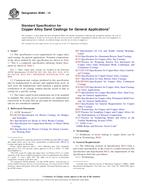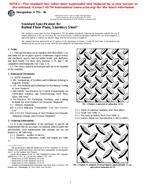Click here to purchase
1.1 These test methods cover the determination of the flash point of petroleum products in the temperature range from 40 to 360° C by a manual Pensky-Martens closed-cup apparatus or an automated Pensky-Martens closed-cup apparatus, and the determination of the flash point of biodiesel in the temperature range of 60 to 190° C by an automated Pensky-Martens closed cup apparatus.
Note 1-Flash point determination as above 250° C can be performed, however, the precision has not been determined above this temperature. For residual fuels, precision has not been determined for flash points above 100° C. The precision of in-use lubricating oils has not been determined. Some specifications state a D93 minimum flash point below 40° C, however, the precision has not been determined below this temperature.
1.2 Procedure A is applicable to distillate fuels (diesel, biodiesel blends, kerosine, heating oil, turbine fuels), new and in-use lubricating oils, and other homogeneous petroleum liquids not included in the scope of Procedure B or Procedure C.
1.3 Procedure B is applicable to residual fuel oils, cutback residua, used lubricating oils, mixtures of petroleum liquids with solids, petroleum liquids that tend to form a surface film under test conditions, or are petroleum liquids of such kinematic viscosity that they are not uniformly heated under the stirring and heating conditions of Procedure A.
1.4 Procedure C is applicable to biodiesel (B100). Since a flash point of residual alcohol in biodiesel is difficult to observe by manual flash point techniques, automated apparatus with electronic flash point detection have been found suitable.
1.5 These test methods are applicable for the detection of contamination of relatively nonvolatile or nonflammable materials with volatile or flammable materials.
1.6 The values stated in SI units are to be regarded as the standard. The values given in parentheses are for information only.
Note 2-It has been common practice in flash point standards for many decades to alternately use a C-scale or an F-scale thermometer for temperature measurement. Although the scales are close in increments, they are not equivalent. Because the F-scale thermometer used in this procedure is graduated in 5 increments, it is not possible to read it to the 2° C equivalent increment of 3.6° F. Therefore, for the purposes of application of the procedure of the test method for the separate temperature scale thermometers, different increments must be used. In this test method, the following protocol has been adopted: When a temperature is intended to be a converted equivalent, it will appear in parentheses following the SI unit, for example 370° C (698° F). When a temperature is intended to be a rationalized unit for the alternate scale, it will appear after “or,” for example, 2° C or 5° F.
Product Details
- Published:
- 11/01/2012
- Number of Pages:
- 18
- File Size:
- 1 file , 240 KB
- Redline File Size:
- 2 files , 480 KB


